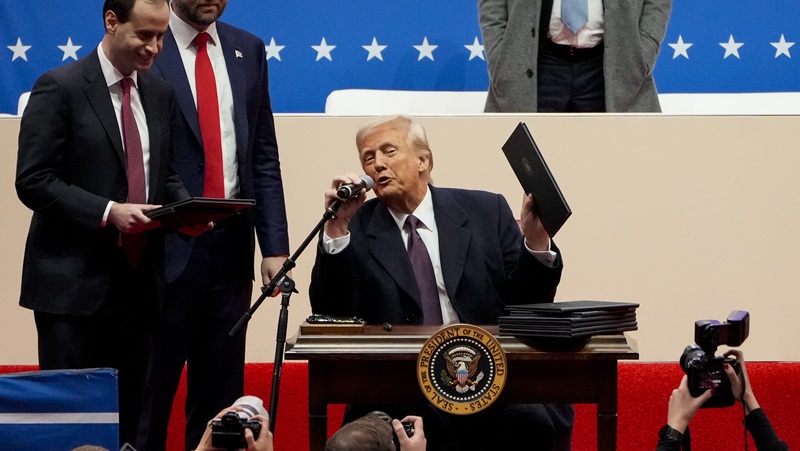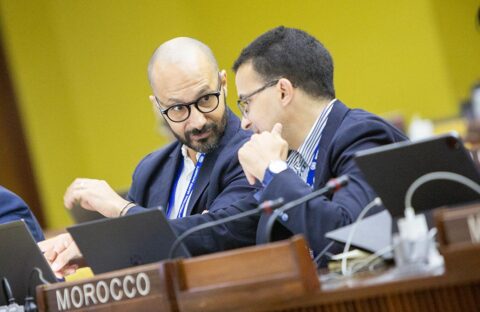No one seems willing to answer citizens’ questions, they say, and public officials don’t seem to care. Will state or federal regulators move to shut down the mine?
OAK GROVE, Ala.—Lily Spicer felt the energy of the explosion surge through her body.
Climate Change
As the Data Center Boom Ramps Up in the Rural Midwest, What Should Communities Expect?
The rapid development will change the Corn Belt in significant, unforeseen ways. Residents are just beginning to grapple with what that means.
TAZEWELL COUNTY, Ill.—To the untrained eye, Central Illinois is all lush fields of corn and green soybeans shortly before harvest. The wind shuffles through the row crops, and the air is warm and humid and full of insects. The horizon is dotted with power lines, strung together by wire, and the occasional water tower—the only objects that disrupt a vast sky.
As the Data Center Boom Ramps Up in the Rural Midwest, What Should Communities Expect?
Climate Change
Why Billions of Gallons of Raw Sewage Keep Ending up in Philadelphia Waterways
With a new analysis showing where the pollution is going, environmental advocates call on public officials to do more to stop it.
PHILADELPHIA—Some 280 years after a river-swimming Benjamin Franklin petitioned to curb water pollution here, the city is still struggling to meet the challenge, according to water advocates who assembled along the banks of one of its two main rivers on Monday.
Why Billions of Gallons of Raw Sewage Keep Ending up in Philadelphia Waterways
Climate Change
UN calls for faster emissions cuts for 2035 as first global estimate disappoints
Global greenhouse gas emissions are estimated to decline over the next decade but at a pace “still not nearly fast enough” to avoid the worst climate impacts, the UN’s top climate official warned as a partial assessment of new national climate plans was released.
UNFCCC Executive Secretary Simon Stiell said global emissions are expected to fall by around 10% by 2035 based on a preliminary assessment of new national climate targets (NDCs) announced by countries that produce nearly 60% of the world’s greenhouse gases.
The Intergovernmental Panel on Climate Change (IPCC) has said that countries should cut their emissions much more rapidly, with a 60% drop from 2019 required by 2035 to limit global warming to 1.5C.
“Ten years after we adopted the Paris Agreement, we can say simply – it is delivering real progress,” said Stiell. “But it must work much faster and fairer, and that acceleration must start now.”
Country delays hamper UN review
Countries are expected to discuss the shortfall in emissions-cutting ambition at next month’s COP30 summit in Belém, Brazil, but it is still unclear what form their response will take.
Stiell said COP30 needs to show nations are still fully on board for climate co-operation, as well as accelerating implementation across all economic sectors and connecting climate action to people’s lives.
But with only two weeks to go until leaders arrive in the Amazon city, most nations – including several big emitters – are yet to even publish an updated climate plan, known as a nationally determined contribution (NDC), after missing multiple deadlines, the last of which was September.
The delay caused a headache for the UN climate officials tasked with producing an official review of emission-cutting targets by the end of this month to inform discussions at COP30. That ‘synthesis report’ was released on Tuesday, alongside Stiell’s speech.
But its authors warned against drawing global conclusions from the numbers it contains because the analysis only covers the 64 countries – responsible for 30% of emissions – that formally submitted their NDCs by the end of September. Since then, a handful more have published their plans, including South Africa and Indonesia.
An update document is set to be published during COP30, when more NDCs should be submitted.
In the meantime, Stiell said the UN climate body (UNFCCC) did “some additional calculations” which, on top of formal NDC submissions, drew on 2035 targets touted by nations in various unofficial formats.
That includes, for example, China, which promised last month during a UN summit in New York to cut emissions by 7-10% from “peak levels”, and the European Union, which announced the bloc’s 2035 target would “range between 66% and 72%” below 1990 levels. Neither has yet published a full NDC.
This UNFCCC calculation, which unlike the synthesis report has not been published, showed that global emissions are projected to fall by 10% from 2019 levels by 2035.
US U-turn clouds global outlook
That headline figure hides a number of uncertainties. Emission-cutting trajectories can change when vague statements are translated into fully fleshed-out climate plans.
Additionally, the assessment includes the targets submitted by the United States – the world’s second largest emitter – in the final weeks of the Biden administration, which aim to cut emissions by 61-66% below 2005 levels by 2035.
But Donald Trump’s return to the White House has all but shredded that plan. The US president has axed climate policies and slashed funding for clean energy, alongside kicking off the process that will see the country leave the Paris Agreement at the start of next year.


State-level authorities and businesses are still likely to push on with some measures to reduce emissions, despite Washington’s pullback, but the extent to which those can help meet the NDC offered by the Biden administration is unclear.
In his speech on Tuesday, Stiell said those taking strong climate action will reap the rewards “measured in millions of new jobs and trillions in new investment”.
“We are still in the race, but to ensure a livable planet for all eight billion people today, we must urgently pick up the pace,” he added.
The post UN calls for faster emissions cuts for 2035 as first global estimate disappoints appeared first on Climate Home News.
UN calls for faster emissions cuts for 2035 as first global estimate disappoints
-
Climate Change2 years ago
Spanish-language misinformation on renewable energy spreads online, report shows
-
Climate Change3 months ago
Guest post: Why China is still building new coal – and when it might stop
-
Climate Change Videos2 years ago
The toxic gas flares fuelling Nigeria’s climate change – BBC News
-

 Greenhouse Gases1 year ago
Greenhouse Gases1 year ago嘉宾来稿:满足中国增长的用电需求 光伏加储能“比新建煤电更实惠”
-
Greenhouse Gases3 months ago
Guest post: Why China is still building new coal – and when it might stop
-

 Climate Change1 year ago
Climate Change1 year ago嘉宾来稿:满足中国增长的用电需求 光伏加储能“比新建煤电更实惠”
-

 Carbon Footprint2 years ago
Carbon Footprint2 years agoUS SEC’s Climate Disclosure Rules Spur Renewed Interest in Carbon Credits
-
Renewable Energy4 months ago
US Grid Strain, Possible Allete Sale






